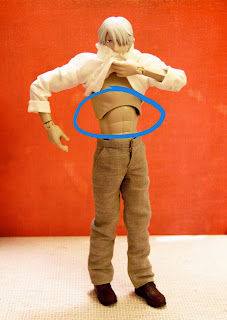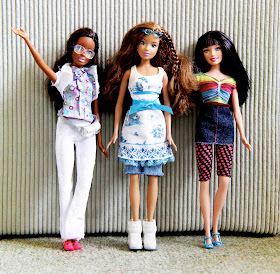Toy collecting readers,
Sometimes a break is so horrible, so ugly, so mushy, so fiddly, that it is pretty much impossible to repair without acquiring... a new part!
In the following paragraphs I will be talking about the most pathetically pathetic figure repair method:
Writing to the manufacturer! :D
I've resorted to this twice and both times it ended well. I got new parts and my toys were repaired in the best possible way.
It is a little awkward and sometimes expensive, but it's also *Arny voice* The Ultimate repair method.
I shall relate my experiences with two Japanese figure companies (most of my figures are Japanese), so you can get a feel for what to expect.
By the way, most contact email addresses can be found buried deep in the bowels of the manufacturer's website. If the website is not in English or anything else you understand, try using Google's built-in translator function to make it easier to find your way around. This can be accessed by searching the page's address on Google.Episode 1: KAITO's Ice-cream
Writing to GSC.
International contact: support@goodsmile.jp
Goodsmile Company is one of the high end figure manufacturers/distributors. They make Nendoroids and lovely scale figures, plus they seem to do a lot of work in tandem with other companies, such as Max Factory (the Figma company) and Phat!... they also have Amaaaaazing customer service. Seriously, they are the nicest company EVER.
So, this is the story...
It was Christmas eve last year and I was mucking around with Nendoroid KAITO.
You've probably seen him before. He's the popular ice-cream loving big brother of Hatsune Miku.
I had posed him with his ice-cream in his hand, but I wanted to put a plain hand on instead, so I went to take the ice-cream out of the hand part, but OH! It was stuck.
"Ha ha," thinks stupid me, "I'll just twist it out."BUT, it was a hot day (in Australia, December is the first month of summer) and some interesting things had happened to the plastic... instead of twisting out of the hand part, it twisted OFF!
 |
| The ice-cream stick is stuck in the hand and the top is broken off! KAITO is understandably upset. (By the way, this face is from Nendoroid Ika Musume.) |
 |
| *hysterical screaming* |
Because the plastic is warped and the paint is torn and broken, even if I glued the ice-cream back on, that fracture would be disgustingly obvious and oh-so-ugly.
Just note:
Honestly, I don't know if this really makes a difference at the end of the day, but it certainly can't hurt. At one point I actually had a bit of a conversation with the chatty GSC staff member, and if I had sent an email with a negative tone to start with, it would have been a much less pleasant experience.
Well, I guess that's my stock of information on this topic exhausted, so as always, Good Luck!
Cheers!
Sparkey.
... So I spent the next few weeks feeling sad about it, but after that I got up the courage to email GSC and beg them for help.
I mentioned before that they are the nicest company ever?
I have only tried this with two companies, but doubtless there are other toy companies out there who would be just as good. It's always worth sending an email, even if they do end up saying no.
THEY ARE THE NICEST COMPANY EVER!
They apologised to me for the trouble KAITO had caused (I would have thought it was me causing them trouble!) and, after I showed them a photo of the broken part, they sent me a replacement hand and ice-cream for free.
Wow!
Does it get any better?
Does it get any better?
 |
| They are not only nice, but they have the friendliest looking letters...! |
I was quite lucky with this, though.
When I broke my KAITO, a new version had just been released; KAITO Cheerful ver. which comes with exactly the same ice-cream parts.
GSC say that they generally only stock spare parts for about a year after the figure (whatever that may be) is released, so if your figure is a few years old, you might not be so lucky.
Still, I suppose it's worth a try. The worst they can say is "Sorry we don't have any".
Episode 2: RAH Roy Mustang
Contacting Medicom Toy.
International contact: overseas@medicomtoy.co.jp
Yes. You heard, er, read right.
RAH Roy Mustang broke again. *facepalm* And this time it was really bad.
I was posing his arm when suddenly his shoulder felt loose.
"Oh crap," I thought.
Oh crap indeed. Roy's left arm had broken off at the shoulder. Due to age and stress, the plastic had crumbled and the metal peg which holds the shoulder joint together had pulled out completely. Worse, there wasn't anywhere to put it back into because the plastic had broken into tiny crumbs.
Look:
 |
| *more hysterical screaming* |
After several unsuccessful attempts at fixing it (including hot glue, epoxy putty and a method which somehow ended up with Roy's shoulder still broken and two small holes accidentally drilled in my desk)...
... I ratted out that international email address and called for help.
(Of course, it was easy to get his arm to stick back on, but the thing about action figures is that they have actual moving parts, so I wasn't happy with my attempts. At best the arm could be moved, but would slowly fall back down under its own weight.)
Medicom were similar in their approach to GSC. They asked for photos and then offered to help me.
They said that installing the new parts was difficult, and that, if I sent Roy to them, they would repair him and install the new parts for me for free!
Woot!
One catch, though. I had to pay the postage.
Well, seriously, that's more than fair. Roy has been discontinued for years and they still offered to fix him for me free of charge.
I did what they told me, they did what they promised, and it was all extremely cool!
They replaced a bunch of Roy's parts, including the broken shoulder, some parts they thought were at risk of breaking in the future and Roy's previously broken and glued neck.
How awesome is Medicom Toy? I am seriously impressed with the amount of responsibility they take for their figures.
I also asked them to send back the old broken parts so that I could experiment on them, and they obliged.
True, they did forget to include the stand when they sent him back, but after I emailed them, they sent me a new stand for free, so I'm happy.
The only, ONLY beef I have with the whole thing was that they sent Roy back to me via FedEx which cost me JP¥5500 (which at the time was the same as US$70). AHHHH! MY PRECIOUS MONEY! What's wrong with EMS? EMS is great! I love EMS! (and money!)
But Roy is, like, the best figure ever so I'm okay with the costs.
Here's a shot of Roy now (and KAITO)...
 |
| Roy demonstrates that his left arm is now fixed. KAITO is on an ice-cream induced high. |
That's not to say you should heckle them about every little thing that goes wrong, though. I would always advocate doing your best to fix the problem by yourself first!
It's guaranteed to be cheap and it's pretty satisfying too! ;D
Just note:
When I contacted both of these companies, I wasn't all like,
you a**wipe My damn figure broke an sh*t you suk fix it or you totaly gon to hell yellow moneky a**hols,,1
... OK, so it's unlikely that a person with grammar liek dis would know an ugly 1940's style racist slur, but I've seen everything else in that 'sentence' repeated over and over by a lot of people who make themselves look like idiots.
I'm guessing that most toy collectors aren't like that (come on, we're a good breed), but I'm often surprised by people's lack of tact~~
Rule No.1 of wanting someone to help you with something: Don't be an arse.
In fact, be as respectful as possible. Nobody has any obligation to help any of us. They just do it because they're awesome! :D
I sent both messages asking for advice on how I could fix the figure myself, because I wasn't really expecting the kind of service I got.
With KAITO, I asked how I could remove the ice-cream from the hand or if I could purchase a replacement. With Roy, I wanted to know whether parts from a Medicom RAH Naked2 figure could be used to replace the broken shoulder.
I also began both emails by complimenting the figures of the respective companies and saying how beautiful they are, how much I love collecting them and expressing my dismay that I was unable to repair them myself. This is of course, an effective suck up the truth.
No, really. It is the truth and it doesn't hurt to say the nice things you think about people ^__^
Honestly, I don't know if this really makes a difference at the end of the day, but it certainly can't hurt. At one point I actually had a bit of a conversation with the chatty GSC staff member, and if I had sent an email with a negative tone to start with, it would have been a much less pleasant experience.
Well, I guess that's my stock of information on this topic exhausted, so as always, Good Luck!
Cheers!
Sparkey.


















































